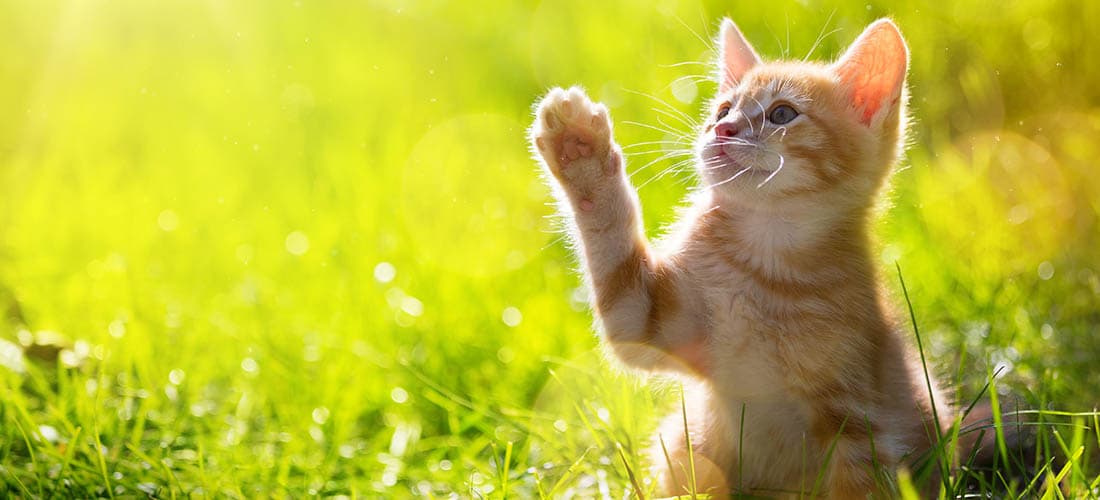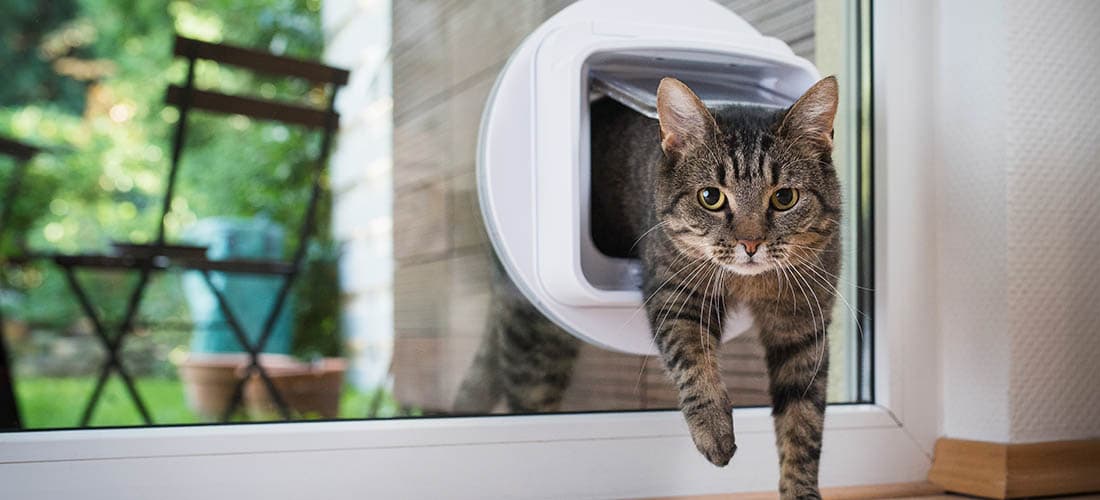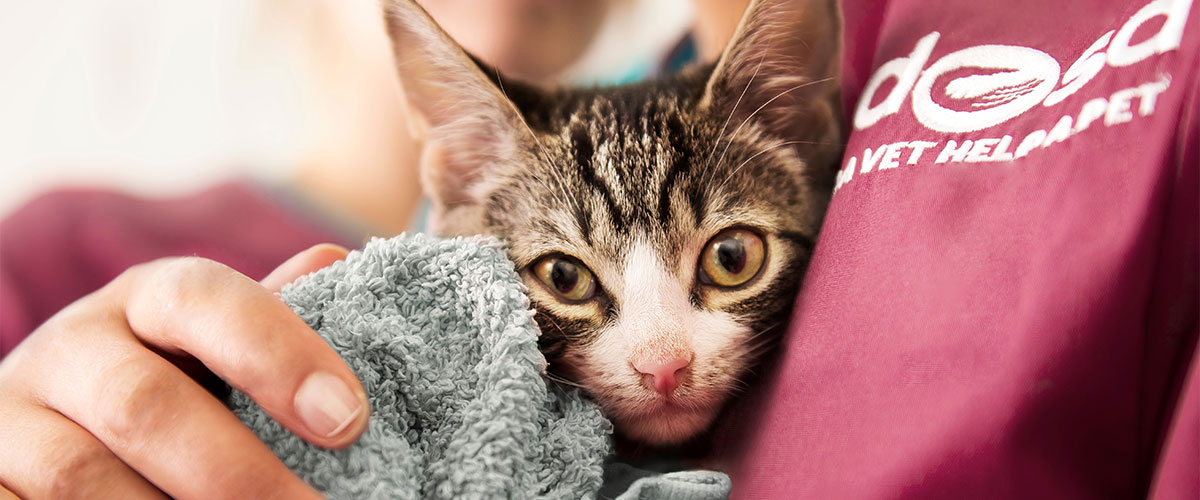Should cats wear collars?
There are lots of reasons why owners may think about putting a collar on their cat, from making sure they don’t get lost, to protecting local wildlife. We know you want to look after your feline friend, but putting a collar on your cat may not be the best way to protect them!
It’s natural to want to make sure your cat is safe and can find their way back to you if they get lost, but we don’t recommend putting a collar on your cat. Unlike dogs, cats have something called a ‘right to roam’. This means, if you have an outdoor cat, they can pretty much go wherever they want. They don’t legally need to wear a collar and the wrong kind of collar can cause problems for them out and about.

While popping a collar on your cat can seem harmless, there are a few problems and dangers you might not know about:
- They could get stuck. Cats are naturally curious and love to explore! This often involves climbing or squeezing their way through hedges and undergrowth, which means they could easily catch their collar on a branch and become trapped. Even if they manage to get free, it’s very easy for them to hurt themselves if they panic or in the struggle to get loose.
- Collars can rub. Wearing a collar all the time, especially if it’s not fitted properly, could rub against your cat’s skin. This can make their skin sore and cause them to lose fur around their neck.
- They could get stuck on the collar itself. Again, if your cat’s collar isn’t fitted properly or becomes loose, they could get it stuck on their mouth or even get a paw stuck in it which can result in serious injuries.
What can I use instead of a collar?

We know there are lots of reasons you might want your cat to wear a collar, so we have some collar-less suggestions that might help:
- Keeping fleas at bay. Flea collars can be an unreliable way to keep pesky pests away. Many types are not very effective at all. Using a regular, vet-approved flea treatment is a much better way to protect your cat from fleas. There’s also the risk that they could lose their flea collar and their flea protection – using a tablet or spot on treatment will help make sure they’re protected at all times! Your vet can advise you further on the best flea treatment for your cat. Read more about protecting your cat against fleas.
- Finding their way back if they get lost. It can be really worrying to think of your four-legged friend getting lost on their travels. The best way to make sure you’re reunited if they stray too far is to get them microchipped (remember to keep their details up-to-date!). A collar with an ID tag can easily get lost, or the ID tag could fall off, but a microchip is a permanent way of making sure anyone who finds your cat can let you know they’re safe and quickly reunite you. Find out more about microchipping.
- Keeping their cat flap private. If you’re worried about other neighbourhood cats coming in and helping themselves to your cat’s food, you might have considered a cat flap with a special collar to open it. But, did you know you can get microchip versions of these? The benefit of a microchip cat flap is that it’ll only open for your cat and there’s no risk of them losing their key! (Well, collar, but still.)
- Protecting the local wildlife. Cats are natural hunters – it’s just who they are. They really can’t help themselves. We understand you’ll want to try and keep the local birds and mice safe from your killer kitty, so a collar with a bell might seem like a good option. There are other ways to try and prevent your cat preying on unsuspecting critters, such as:
- Keeping any bird feeders at least 2m away from trees and bushes so birds can see your cat coming
- Make sure any nest boxes are not accessible to your cat (including where the young birds might be first coming out to learn how to fly)
- Pop bird feeders on metal poles your cat can’t climb
- Try to keep your cat indoors at prime hunting time (just after sunrise and just before sunset)
- Play with your kitty so they can practice their hunting skills inside instead of on other animals. Take a look at our exercise advice for ideas of how to keep your cat active indoors.
If I get a collar for my cat, how can I make sure it’s safe?
We do not recommend collars, but if you decide a collar is right for your cat, there are some key things to remember:
- Fitting. It’s super important to make sure your cat’s collar fits correctly. You should be able to comfortable slide two fingers under their collar while it’s on. Any tighter and it could hurt them, any looser and it could catch out and about. Check again once the collar has been on your cat for a few minutes: they may have hunched up when you first tried it on!
- Quick release. Any collar you get for your cat needs to be a ‘quick release’ collar. This means if they get caught on a branch or even on their own paw, the plastic buckle will come apart so they’re less likely to hurt themselves. Check that the quick release does what it says and could easily come apart without you cat struggling. Make sure you check the release regularly, as they can become blocked with dirt and grease and no longer open as easily as they should. Do not use collars with elastic inserts as these can cause serious injuries.
- Quality. If you’re getting a collar for your cat, make sure it’s good quality. Poor quality collars can easily come apart or parts can fall off and be swallowed by curious cats.
- Avoid decoration. Some collars do look very pretty, but these little extras may cause your cat harm. Buckles and studs can rub while glitter can be itchy and uncomfortable.
Cat exercise
Playing with toys is great exercise for cats. Find out what kinds of games they love to play and which toys can help keep them active.
Read moreYour cat's weight
Find out how to do a simple, at-home check of you cat to help you keep your cat's weight in check.
Read moreCat health
Prevention is always better than cure – and there’s lots of things you can do to keep your cat happy and healthy.
Read more
